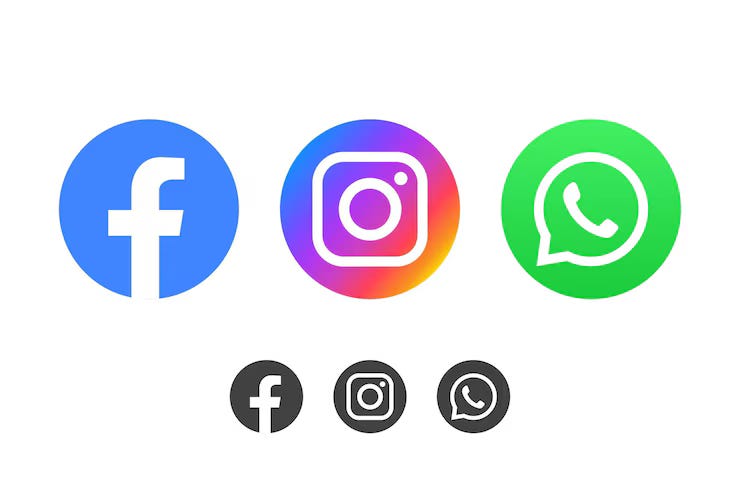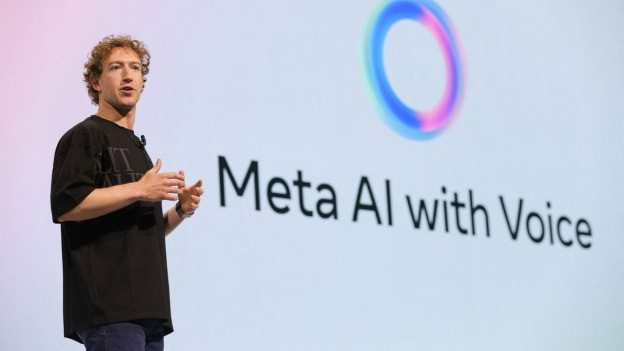Hey everyone! Long time no see, I know. I haven't published a newsletter in the last two months, but starting today, I'm trying to be consistent, so fingers crossed! Let's deep dive into today's newsletter.
Today's Newsletter is divided into 3 parts:
1️⃣ In the first part, I discussed how Meta started. 🏁
2️⃣ In the second, I covered how Meta acquired its kingdom. (This will likely involve key acquisitions like Instagram and WhatsApp). 🏰
3️⃣ In the third, Meta Rebranding & Future. 🚀
So Let’s Begin! 🏎️💨
In 2004, what started as a social networking site by Mark Zuckerberg has evolved into a company that has, on average, 3.43 billion users across the globe (according to its Q1 2025 Report). This is almost 41.83% of the world's population ( 8.2 billion in 2025 ), I don't know anyone who doesn't use Meta services on a daily basis, unless they live in North Korea. 😂
Anyway, let's break down the Meta empire to understand it better.
1️⃣ How Meta Started ? .
In October 2003, Mark Zuckerberg created a Hot-or-Not-style website called Facemash that let students rate the attractiveness of their classmates, as Mark was a Harvard student at that time. The site garnered over 22,000 votes in two days before being shut down by Harvard admins for breaching privacy and security policies.
The site gets over 22,000 votes in 2 days before being shut down by Harvard admins for breaching privacy and security policies.
Then, in January 2004, Mark started working on a new social networking site for Harvard students with his classmates Eduardo Saverin, Dustin Moskovitz, and Chris Hughes. In February 2004, TheFaceBook.com was launched. Within a month, over half of Harvard undergraduates had registered. Over the next few months, TheFacebook expanded to include high schools, colleges, and employees.
In June 2005, the company officially changed its name to Facebook.
Three months later, Facebook launched membership eligibility for employees of companies like Apple and Microsoft. In December 2005, Facebook reached 6 million active users. Later in September 2006, Facebook membership is opened up to anyone aged 13 and older with a valid email address.
Between 2004 and 2007, Facebook launched several features like "the Wall," which allowed friends to post messages; unlimited photo uploads; the News Feed feature; Facebook Pages; Facebook Marketplace, and more. Fun fact: these features are still around today.
Later that year, at a Facebook social advertising event on November 6, 2007, the Facebook Ads platform was unveiled. Facebook removed the subscription model and made Facebook accessible to everyone.
The Facebook Ads platform had three parts: Facebook Pages, Facebook Social Ads, and a user interface to gather insights about user behavior. At the time, over 100,000 Facebook Pages launched, making the platform a big success. By 2007, Facebook surpassed MySpace as the #1 social media site in terms of traffic.
But the grass isn't always greener. Today, competition is intense, with more social media companies emerging. Consumer behavior is changing, and people are using platforms like Instagram, TikTok, etc., more than Facebook. But does that mean Facebook is dead? 🤔 Let's see what the reports say.
And according to reports, Facebook is still one of the world’s most popular social media platforms. Based on data published in its own ad planning resources, Facebook had at least 2.28 billion users around the world in January 2025.
Meanwhile, it may also be useful to know that Facebook ads reached 39.4 percent of all the world’s adults aged 18 and above in January 2025. Meta’s ad planning tools suggest that Facebook’s global potential audience reach figure increased by 4.3 percent in the preceding 12 months. To put that figure in perspective, marketers were able to reach 93.3 million more users with Facebook ads in January 2025 than they were one year prior. That’s impressive!
In India, Facebook had approximately 375 million active users, and in the United States of America, it had around 194 million active Facebook users in January 2025.
So, the OG is not dead yet! And because of Meta ads and its revenue, Facebook remains unmatched by its competitors. Due to its diverse audience, it's the No. 1 choice for marketers and content creators. So, Facebook is still relevant, and to make Meta relevant, Meta also owns other social media sites like Instagram, WhatsApp, etc. Let’s talk about them.
2️⃣ The acquired kingdom 🤺
The acquisitions of Instagram and WhatsApp were direct responses to a strategic need in the fast-moving technology sector. The new generation of social media users was gravitating towards mobile-first applications, such as Snapchat. This indicated a growing vulnerability for Facebook, as its traditional desktop-centric model faced challenges in capturing the attention of a mobile-native audience. (By the way, the Facebook mobile app launched in July 2008, so they were trying to adapt too!)
Instagram and WhatsApp were precisely the kind of apps Meta needed.
Instagram, founded by Kevin Systrom and Mike Krieger in 2010, primarily focused on featuring photographs, especially those taken on Apple mobile devices. Within months of its launch, Instagram saw a rapid rise in its user base, achieving 1 million registered users within two months of its iOS launch and 10 million within a year. They began luring a ton of investors. According to reports, Twitter wanted to acquire Instagram and made a formal offer of around $500 million in stock, but Systrom refused to accept it.
On the other hand, Brian Acton and Jan Koum launched WhatsApp in 2009 after leaving their jobs at Yahoo! WhatsApp is Facebook's most important acquisition, over 20 times larger than its Instagram purchase, making quite the splash in 2014. When early versions of WhatsApp kept crashing, Koum considered giving up and looking for a new job. Acton encouraged him to wait for "a few more months." In June 2009, when the app had been downloaded by only a handful of Fishman's Russian-speaking friends, Apple launched push notifications, allowing users to be pinged even when not using the app.
WhatsApp 2.0, released for iPhone in August 2009, featured a purpose-designed messaging component; the number of active users suddenly increased to 250,000. To cover the cost of sending verification texts to users, WhatsApp was changed from a free service to a paid one. In December 2009, the ability to send photos was added to the iOS version. By early 2011, WhatsApp was one of the top 20 apps in the U.S. Apple App Store. Facebook noticed both vulnerability and opportunity in WhatsApp.
Facebook didn’t want to lose its ground and also saw upcoming competition as a threat. To counter this, Facebook needed to acquire platforms that were thriving in the mobile-first space and appealing to younger demographics. Instagram, a rapidly growing mobile-first photo-sharing application, and WhatsApp represented a crucial entry into the mobile-first platform. Secondly, the acquisition granted Facebook access to WhatsApp's vast global user base and market penetration. Thirdly, WhatsApp provided Facebook with access to mobile numbers as unique identifiers.
So, in April 2012, Facebook Inc. acquired Instagram for approximately US$1 billion in cash and stock. In February 2014, Facebook acquired WhatsApp for $19 billion, leaving everyone wondering.
Instagram evolved substantially beyond its original identity as a simple photo-sharing application. Key additions to its feature set included Direct Messages in 2013, the highly successful Stories feature in 2016, Instagram Shopping also in 2016, IGTV in 2018, and Reels in 2020. The platform increasingly embraced audio and video content, directly positioning itself to compete with emerging platforms like TikTok. Today, Instagram has at least 1.74 billion users around the world.
On the other hand, upon the acquisition, both Facebook and WhatsApp publicly emphasized that WhatsApp would operate as an independent company. WhatsApp's appeal was its motto of "no ads, no games, no gimmicks," and assurances were given that the product would remain ad-free, with explicit promises about user data.
But despite the initial promises, Meta began to aggressively pursue monetization strategies for WhatsApp. "Click-to-WhatsApp" ads, which allow users to initiate direct conversations with businesses from advertisements displayed on Facebook and Instagram, emerged as Meta's fastest-growing ad format, generating approximately $10 billion in revenue in 2024. In June 2025, Meta took a more direct step by introducing advertisements within WhatsApp's "Updates" tab. WhatsApp now has 3 billion monthly active users globally.
3️⃣ Meta Rebranding & Future. 🚀
If you're still reading, you know Meta started as Facebook, a social media site, and acquired multiple social media sites to become a social media giant. But here’s the thing: Meta is also focusing on other technologies like the Metaverse and AI.
From 2004 to 2021, we knew Meta as Facebook Inc. Both the Facebook platform and the parent company managing all operations were called Facebook. But on October 28, 2021, Facebook officially rebranded to Meta, reflecting the company's broader focus on the metaverse. Meta (formerly Facebook) has been developing a metaverse, investing heavily in virtual reality (VR) and augmented reality (AR) technologies, and after the boom of ChatGPT, Meta also started working on AI technology.
Today, Meta's ad business is strong because it has a massive 3.43 billion daily users across all platforms. Meta earned $42.31 billion in Q1, an increase of 16% year-over-year. Meta's total costs and expenses for Q1 were $24.76 billion, an increase of 9% year-over-year. In the development of AI infrastructure, Meta already spent $13.69 billion, according to the Q1 Report. Meta is also focusing on micro-blogging social media sites like X.com (formerly Twitter) and launched the Threads app on July 5, 2023. Today, the Threads app has 350 million monthly active users globally and has also launched ads for global advertisers.
So you can see, Meta has a magic formula, from ads to acquiring competitors; Meta knows how to monetize. That's why today, Meta is No. 1 in the social media space and is also shaping almost 41.83% of the world's population. This is a scary part also, but today Meta is focusing on AI. Recently, it launched video editing through prompts from Meta AI and also launched a video editing app called Edits. What's the future? Nobody knows, but today Meta is a household name in tech. Despite its ups and downs, today video creators are rising, and even small to big businesses can run ads on Meta.
So Meta and its platforms are the most important tools in your content and ads strategy. If you are someone who needs help with content or needs help running ads on Meta Platforms, you can jump on a call with me.
Book Here 👉 : https://cloudguerrilla.in/booking/
I'm happy to help you!
Phew 😅 That's it for today. Subscribe to my newsletter, or you can join my WhatsApp Community.
Share this newsletter with anyone who needs it. Thanks for reading! See you with a new newsletter. Until then, Peace out ☮️ ✌️









